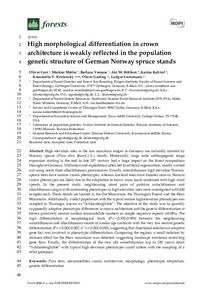Показать сокращенную информацию
Hight morphological differentiation in crown architecture is weakly reflected in the population genetic structure of German Norway spruce stands.
| Автор | Oliver, Caré | |
| Автор | Markus, Müller | |
| Автор | Barbara, Vornam | |
| Автор | Aki M. Höltken | |
| Автор | Karina, Kahlert | |
| Автор | Konstantin V. Krutovsky | |
| Автор | Oliver, Gailing | |
| Автор | Ludger, Leinemann | |
| Дата внесения | 2020-01-20T08:01:51Z | |
| Дата, когда ресурс стал доступен | 2020-01-20T08:01:51Z | |
| Дата публикации | 2018-12 | |
| Библиографическое описание | Oliver, Caré. Hight morphological differentiation in crown architecture is weakly reflected in the population genetic structure of German Norway spruce stands. [Текст] / Caré Oliver, Müller Markus, Vornam Barbara, Aki M. Höltken, Kahlert Karina, Konstantin V. Krutovsky, Gailing Oliver, Leinemann Ludger // Forests. — 2018. — 9(12) (№ 752). | |
| ISSN | 19994907 | |
| URI (для ссылок/цитирований) | https://www.mdpi.com/1999-4907/9/12/752/htm | |
| URI (для ссылок/цитирований) | https://elib.sfu-kras.ru/handle/2311/129605 | |
| Аннотация | High elevation sites in the low mountain ranges in Germany are naturally covered by Norway spruce (Picea abies [Karst.] L.) stands. Historically, large scale anthropogenic range expansion starting in the mid to late 18th century had a huge impact on the forest composition throughout Germany. Utilisation and exploitation often led to artificial regeneration, mostly carried out using seeds from allochthonous provenances. Usually autochthonous high elevation Norway spruce trees have narrow crown phenotypes, whereas lowland trees have broader crowns. Narrow crown phenotypes are likely due to the adaptation to heavy snow loads combined with high wind speeds. In the present study, neighbouring stand pairs of putative autochthonous and allochthonous origin with contrasting phenotypes in high elevation sites were investigated with 200 samples each. These stands are located in the Ore Mountains, the Thuringian Forest, and the Harz Mountains. Additionally, a relict population with the typical narrow high elevation phenotypes was sampled in Thuringia, known as “Schlossbergfichte”. The objective of the study was to quantify supposedly adaptive phenotypic differences in crown architecture and the genetic differentiation at eleven putatively neutral nuclear microsatellite markers or simple sequence repeats (nSSRs). The high differentiation at morphological traits (PST = 0.952-0.989) between the neighbouring autochthonous and allochthonous stands of similar age contrasts with the very low neutral genetic differentiation (FST = 0.002-0.007; G’’ST = 0.002-0.030), suggesting that directional selection at adaptive gene loci was involved in phenotypic differentiation. Comparing the regions, a small isolation by distance effect for the Harz mountains was detected, suggesting landscape resistance restricting gene flow. Finally, the differentiation of the very old autochthonous (up to 250 years) stand “Schlossbergfichte” with typical high elevation phenotypes could cohere with the sampling of a relict genepool. | |
| Тема | Picea abies | |
| Тема | microsatellites | |
| Тема | crown architecture | |
| Тема | morphology | |
| Тема | phenotypic adaptation | |
| Тема | genetic differentiation | |
| Название | Hight morphological differentiation in crown architecture is weakly reflected in the population genetic structure of German Norway spruce stands. | |
| Тип | Journal Article | |
| Тип | Journal Article Postprint | |
| ГРНТИ | 34.15.23 | |
| Дата обновления | 2020-01-20T08:01:50Z | |
| DOI | 10.3390/f9120752 | |
| Институт | Институт фундаментальной биологии и биотехнологии | |
| Подразделение | Базовая кафедра защиты и современных технологии мониторинга лесов | |
| Журнал | Forests | |
| Квартиль журнала в Scopus | Q1 | |
| Квартиль журнала в Web of Science | Q2 |

